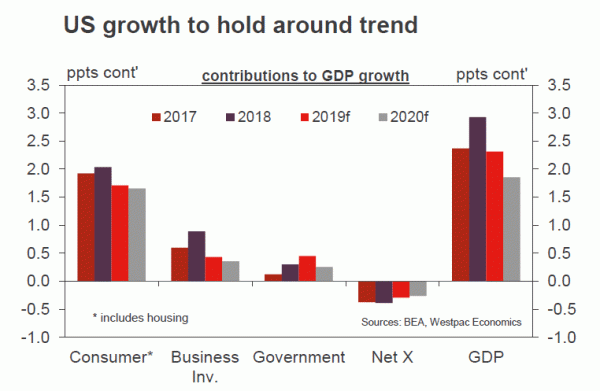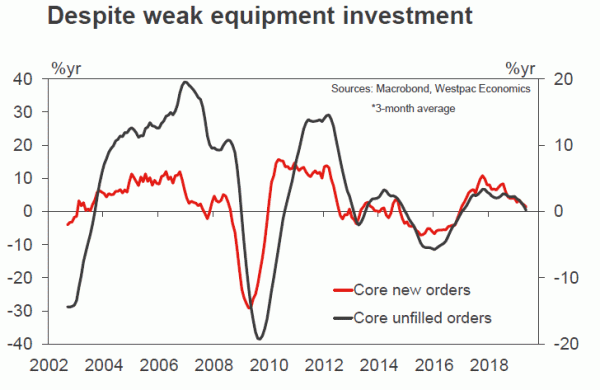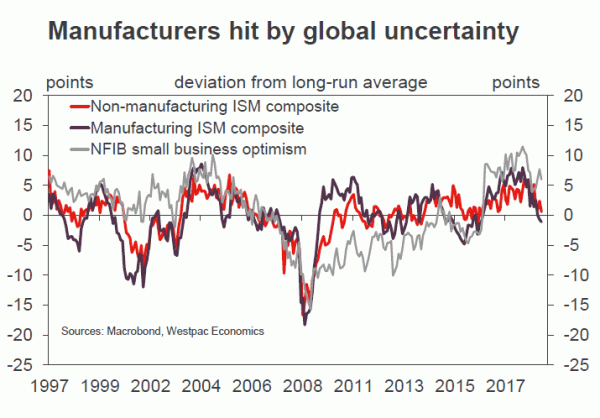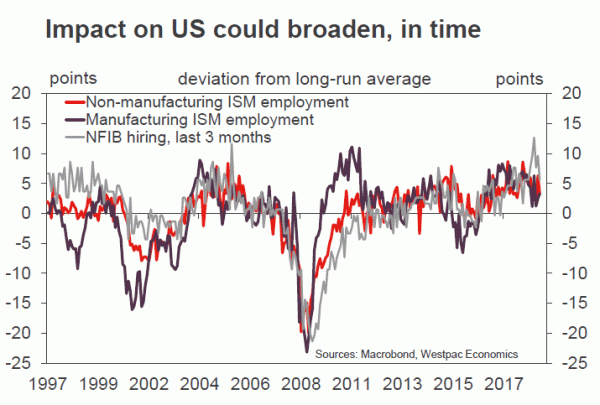As expected by Westpac and the market, the FOMC cut the federal funds rate by 25bps at its July meeting, taking the mid-point of the target range to 2.125%. The Committee also announced that the balance sheet run-off would end two months earlier than planned, stabilising the size of the balance sheet from August.
Being the first policy easing since 2008, this is a significant development and is highly unlikely to be a one-off. The question is, are we set for two cuts over the coming year (as Westpac expects), or four as the market had priced ahead of the meeting? The headline message of Chair Powell in the press conference was that this is a “mid-cycle adjustment” and “not the beginning of a long series of rate cuts”. These comments along with their median projection of two cuts in 2019 at the 18-19 June meeting and today’s two dissenters all point to the Committee being of the belief that the cumulative scale of cuts over the coming year is most likely to be 50bps rather than 100bps.
Part of the reason this is the case is that Chair Powell and the Committee believe today’s rate cut (and the one to follow) cannot be assessed in isolation. Instead it must be taken together with the progressive shift in the Committee’s stance through 2019, from signalling more rate hikes at the end of 2018 to cuts at June 2019. As a result, financial conditions have improved materially through 2019: the US 10yr yield has fallen from around 2.80% at the time of the December 2018 meeting to 2.04% currently; and the S&P500 index has risen circa 20% – to a level the Committee and Chair Powell still see as consistent with fundamentals rather than market exuberance over lower rates.
The other support for this “adjustment” view is that the Committee’s baseline economic expectation remains robust. Highlighting this, in the statement the Committee note that “the labor market remains strong and that economic activity has been rising at a moderate rate”, helped by growth in household spending… “pick[ing] up from earlier in the year” and despite business fixed investment remaining “soft”. Further, on inflation, the Committee remains of the view that a return to 2% is “most likely”.
To trigger a long series of rate cuts, as per the press conference, “real economic weakness” instead needs to be seen. To our mind, the trigger for such a turn in policy would be the passing of current (or future) weakness in business investment into employment and wages, and consequently to consumption. This would most likely come as a result of further weakness in world growth and persistent global uncertainty.
In assessing the probability of such an outcome, global trade and sentiment will remain key, so too the strength of the US dollar – particularly with respect to US competitiveness and expected US corporate profitability, but also as it affects inflation.
In short, if trade tensions were to increase; a hard Brexit be seen; and/or if the US dollar rallied materially from its already-elevated level (on the back of out-sized action from the ECB or softer global growth), then the FOMC would have cause to consider undertaking more than one additional cut over the coming 12 months. Disappointment on inflation could also trigger a response. At this stage however, each of these potential eventualities should be considered risks to the rates outlook not part of a base case given their likelihood and timing is highly unpredictable.
For the coming year, a total of 50bps of cuts (including July) remains our central view. Of the remaining meetings, October seems the most likely timing for the second cut, providing time to assess the data flow while still signalling a pro-active policy stance.
Looking past mid-2020 however, there is reason to price risk of further action from the FOMC. Simply, global uncertainties are unlikely to dissipate between now and then; and, while the deterioration in global growth is likely at its nadir, a meaningful acceleration in momentum seems improbable. Domestically, by late-2020 employment growth will have slowed such that the downtrend in the unemployment rate will also be at risk of reversal, restricting income growth and hence consumer spending. US GDP will certainly then be at risk of disappointing trend, potentially warranting an outright ‘easy’ policy stance into 2021


















